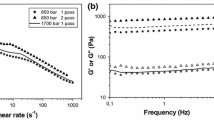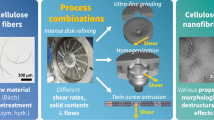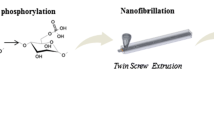Abstract
The commercialization of cellulose nanofibrils (CNF) is limited due to the high energy consumed during production. Twin-screw extrusion has recently been employed for the energy-efficient production of CNF with high solid content, but the method requires several passes. Cellulose nanofibrils have been produced by using both a twin-screw extruder and a homogenizer. Some combinations require a fewer number of passes thereby using less energy, while maintaining the desired CNF quality. The morphology and quality of CNF were characterized by optical microscopy, MorFi analysis, and with a recently developed quality index. The combination of one pass through the twin-screw extruder and two passes through the homogenizer decreases energy consumption by 45%. These CNF have a similar quality to CNF produced after five passes through the homogenizer alone.








Similar content being viewed by others
References
Turbak AF, Snyder FW, Sandberg KR (1983) Microfibrillated cellulose, a new cellulose product: properties, uses, and commercial potential. J Appl Polym Sci Appl Polym Symp 37:815–827
Mariano M, El Kissi N, Dufresne A (2014) Cellulose nanocrystals and related nanocomposites: review of some properties and challenges. J Polym Sci B Polym Phys 52:791–806. https://doi.org/10.1002/polb.23490
Oksman K, Aitomäki Y, Mathew AP et al (2016) Review of the recent developments in cellulose nanocomposite processing. Compos Part Appl Sci Manuf 83:2–18. https://doi.org/10.1016/j.compositesa.2015.10.041
Hoeng F, Denneulin A, Bras J (2016) Use of nanocellulose in printed electronics: a review. Nanoscale 8:13131–13154. https://doi.org/10.1039/C6NR03054H
Lin N, Huang J, Dufresne A (2012) Preparation, properties and applications of polysaccharide nanocrystals in advanced functional nanomaterials: a review. Nanoscale 4:3274–3294. https://doi.org/10.1039/c2nr30260h
Jorfi M, Foster EJ (2015) Recent advances in nanocellulose for biomedical applications. J Appl Polym Sci. https://doi.org/10.1002/app.41719
Isogai A, Saito T, Fukuzumi H (2011) TEMPO-oxidized cellulose nanofibers. Nanoscale 3:71–85. https://doi.org/10.1039/C0NR00583E
Saini S, Yücel Falco Ç, Belgacem MN, Bras J (2016) Surface cationized cellulose nanofibrils for the production of contact active antimicrobial surfaces. Carbohydr Polym 135:239–247. https://doi.org/10.1016/j.carbpol.2015.09.002
Chaker A, Boufi S (2015) Cationic nanofibrillar cellulose with high antibacterial properties. Carbohydr Polym 131:224–232. https://doi.org/10.1016/j.carbpol.2015.06.003
He H, Chen J, Wang SF et al (2011) Preparation of cationic cellulose obtained from wood pulp using the microwave. Adv Mater Res 295–297:734–737. https://doi.org/10.4028/www.scientific.net/AMR.295-297.734
Ghanadpour M, Carosio F, Larsson PT, Wågberg L (2015) Phosphorylated cellulose nanofibrils: a renewable nanomaterial for the preparation of intrinsically flame-retardant materials. Biomacromol 16:3399–3410. https://doi.org/10.1021/acs.biomac.5b01117
Naderi A, Lindström T, Weise CF, Flodberg G, Sundström J, Junel K, Erlandsson J, Runebjörk A (2016) Phosphorylated nanofibrillated cellulose: production and properties. Nord Pulp Pap Res J 31:020–029. https://doi.org/10.3183/NPPRJ-2016-31-01-p020-029
Noguchi Y, Homma I, Matsubara Y (2017) Complete nanofibrillation of cellulose prepared by phosphorylation. Cellulose 24:1295–1305. https://doi.org/10.1007/s10570-017-1191-3
Spence KL, Venditti RA, Rojas OJ et al (2011) A comparative study of energy consumption and physical properties of microfibrillated cellulose produced by different processing methods. Cellulose 18:1097–1111. https://doi.org/10.1007/s10570-011-9533-z
Josset S, Orsolini P, Siqueira G, Tejado A, Tingaut P, Zimmermann T (2014) Energy consumption of the nanofibrillation of bleached pulp, wheat straw and recycled newspaper through a grinding process. Nord Pulp Pap Res J 29:167–175. https://doi.org/10.3183/NPPRJ-2014-29-01-p167-175
Nair SS, Zhu JY, Deng Y, Ragauskas AJ (2014) Characterization of cellulose nanofibrillation by micro grinding. J Nanoparticle Res 16:2349. https://doi.org/10.1007/s11051-014-2349-7
Eriksen Syverud K, Gregersen O (2008) The use of microfibrillated cellulose produced from kraft pulp as strength enhancer in TMP paper. Nord Pulp Pap Res J 23:299–304. https://doi.org/10.3183/NPPRJ-2008-23-03-p299-304
Naderi A, Lindström T, Erlandsson J et al (2016) A comparative study of the properties of three nano-fibrillated cellulose systems that have been produced at about the same energy consumption levels in the mechanical delamination step. Nord Pulp Pap Res J 31:364–371. https://doi.org/10.3183/NPPRJ-2016-31-03-p364-371
Tejado A, Alam MN, Antal M et al (2012) Energy requirements for the disintegration of cellulose fibers into cellulose nanofibers. Cellulose 19:831–842. https://doi.org/10.1007/s10570-012-9694-4
Saito T, Kimura S, Nishiyama Y, Isogai A (2007) Cellulose nanofibers prepared by TEMPO-mediated oxidation of native cellulose. Biomacromol 8:2485–2491. https://doi.org/10.1021/bm0703970
Pääkkö M, Ankerfors M, Kosonen H et al (2007) Enzymatic hydrolysis combined with mechanical shearing and high-pressure homogenization for nanoscale cellulose fibrils and strong gels. Biomacromol 8:1934–1941. https://doi.org/10.1021/bm061215p
Henriksson M, Henriksson G, Berglund LA, Lindström T (2007) An environmentally friendly method for enzyme-assisted preparation of microfibrillated cellulose (MFC) nanofibers. Eur Polym J 43:3434–3441. https://doi.org/10.1016/j.eurpolymj.2007.05.038
Correia VC, dos Santos V, Sain M et al (2016) Grinding process for the production of nanofibrillated cellulose based on unbleached and bleached bamboo organosolv pulp. Cellulose 23:2971–2987. https://doi.org/10.1007/s10570-016-0996-9
Bulota M, Kreitsmann K, Hughes M, Paltakari J (2012) Acetylated microfibrillated cellulose as a toughening agent in poly(lactic acid). J Appl Polym Sci 126:E449–E458. https://doi.org/10.1002/app.36787
Taipale T, Österberg M, Nykänen A et al (2010) Effect of microfibrillated cellulose and fines on the drainage of kraft pulp suspension and paper strength. Cellulose 17:1005–1020. https://doi.org/10.1007/s10570-010-9431-9
Taheri H, Samyn P (2016) Effect of homogenization (microfluidization) process parameters in mechanical production of micro- and nanofibrillated cellulose on its rheological and morphological properties. Cellulose 23:1221–1238. https://doi.org/10.1007/s10570-016-0866-5
Zimmermann T, Pöhler E, Geiger T (2004) Cellulose fibrils for polymer reinforcement. Adv Eng Mater 6:754–761. https://doi.org/10.1002/adem.200400097
Dinand E, Chanzy H, Vignon RM (1999) Suspensions of cellulose microfibrils from sugar beet pulp. Food Hydrocoll 13:275–283. https://doi.org/10.1016/S0268-005X(98)00084-8
Iwamoto S, Nakagaito AN, Yano H (2007) Nano-fibrillation of pulp fibers for the processing of transparent nanocomposites. Appl Phys A 89:461–466. https://doi.org/10.1007/s00339-007-4175-6
Leitner J, Hinterstoisser B, Wastyn M et al (2007) Sugar beet cellulose nanofibril-reinforced composites. Cellulose 14:419–425. https://doi.org/10.1007/s10570-007-9131-2
Iwamoto S, Nakagaito AN, Yano H, Nogi M (2005) Optically transparent composites reinforced with plant fiber-based nanofibers. Appl Phys A 81:1109–1112. https://doi.org/10.1007/s00339-005-3316-z
Naderi A, Lindström T, Sundström J (2015) Repeated homogenization, a route for decreasing the energy consumption in the manufacturing process of carboxymethylated nanofibrillated cellulose? Cellulose 22:1147–1157. https://doi.org/10.1007/s10570-015-0576-4
Nakagaito AN, Yano H (2004) The effect of morphological changes from pulp fiber towards nano-scale fibrillated cellulose on the mechanical properties of high-strength plant fiber based composites. Appl Phys A 78:547–552. https://doi.org/10.1007/s00339-003-2453-5
Kekäläinen K, Liimatainen H, Biale F, Niinimäki J (2015) Nanofibrillation of TEMPO-oxidized bleached hardwood kraft cellulose at high solids content. Holzforschung 69:1077–1088. https://doi.org/10.1515/hf-2014-0269
Phanthong P, Karnjanakom S, Reubroycharoen P et al (2017) A facile one-step way for extraction of nanocellulose with high yield by ball milling with ionic liquid. Cellulose 24:2083–2093. https://doi.org/10.1007/s10570-017-1238-5
Dufresne A, Cavaillé J-Y, Vignon MR (1997) Mechanical behavior of sheets prepared from sugar beet cellulose microfibrils. J Appl Polym Sci 64:1194. https://doi.org/10.1002/(SICI)1097-4628(19970509)64:6<1185::AID-APP19>3.0.CO;2-V
Wang B, Sain M, Oksman K (2007) Study of structural morphology of hemp fiber from the micro to the nanoscale. Appl Compos Mater 14:89. https://doi.org/10.1007/s10443-006-9032-9
Bhatnagar A, Sain M (2005) Processing of cellulose nanofiber-reinforced composites. J Reinf Plast Compos 24:1259–1268. https://doi.org/10.1177/0731684405049864
Chen W, Yu H, Liu Y et al (2011) Individualization of cellulose nanofibers from wood using high-intensity ultrasonication combined with chemical pretreatments. Carbohydr Polym 83:1804–1811. https://doi.org/10.1016/j.carbpol.2010.10.040
Santucci BS, Bras J, Belgacem MN et al (2016) Evaluation of the effects of chemical composition and refining treatments on the properties of nanofibrillated cellulose films from sugarcane bagasse. Ind Crops Prod 91:238–248. https://doi.org/10.1016/j.indcrop.2016.07.017
Wang S, Cheng Q (2009) A novel process to isolate fibrils from cellulose fibers by high-intensity ultrasonication, Part 1: process optimization. J Appl Polym Sci 113:1270–1275. https://doi.org/10.1002/app.30072
Cherian BM, Leão AL, de Souza SF et al (2010) Isolation of nanocellulose from pineapple leaf fibres by steam explosion. Carbohydr Polym 81:720–725. https://doi.org/10.1016/j.carbpol.2010.03.046
Deepa B, Abraham E, Cherian BM et al (2011) Structure, morphology and thermal characteristics of banana nano fibers obtained by steam explosion. Bioresour Technol 102:1988–1997. https://doi.org/10.1016/j.biortech.2010.09.030
Ho TTT, Abe K, Zimmermann T, Yano H (2014) Nanofibrillation of pulp fibers by twin-screw extrusion. Cellulose 22:421–433. https://doi.org/10.1007/s10570-014-0518-6
Baati R, Magnin A, Boufi S (2017) High solid content production of nanofibrillar cellulose via continuous extrusion. ACS Sustain Chem Eng. https://doi.org/10.1021/acssuschemeng.6b02673
Rol F, Karakashov B, Nechyporchuk O et al (2017) Pilot scale twin screw extrusion and chemical pretreatment as an energy efficient method for the production of nanofibrillated cellulose at high solid content. ACS Sustain Chem Eng. https://doi.org/10.1021/acssuschemeng.7b00630
Heiskanen I, Harlin A, Backfolk K, Laitinen R (2011) Process for production of microfibrillated cellulose in an extruder and microfibrillated cellulose produced according to the process
Eymin Petot Tourtollet G, Cottin F, Cochaux A, Petit-Conil M (2003) The use of MorFi analyser to characterise mechanical pulps
Desmaisons J, Boutonnet E, Rueff M et al (2017) A new quality index for benchmarking of different cellulose nanofibrils. Carbohydr Polym 174:318–329. https://doi.org/10.1016/j.carbpol.2017.06.032
Zimmermann T, Bordeanu N, Strub E (2010) Properties of nanofibrillated cellulose from different raw materials and its reinforcement potential. Carbohydr Polym 79:1086–1093. https://doi.org/10.1016/j.carbpol.2009.10.045
Moser C, Lindström ME, Henriksson G (2015) Toward industrially feasible methods for following the process of manufacturing cellulose nanofibers. BioResources 10:2360–2375. https://doi.org/10.15376/biores.10.2.2360-2375
Yano H, Sugiyama J, Nakagaito AN et al (2005) Optically transparent composites reinforced with networks of bacterial nanofibers. Adv Mater 17:153–155. https://doi.org/10.1002/adma.200400597
Nechyporchuk O, Pignon F, Belgacem MN (2015) Morphological properties of nanofibrillated cellulose produced using wet grinding as an ultimate fibrillation process. J Mater Sci 50:531–541. https://doi.org/10.1007/s10853-014-8609-1
Siqueira G, Tapin-Lingua S, Bras J et al (2010) Morphological investigation of nanoparticles obtained from combined mechanical shearing, and enzymatic and acid hydrolysis of sisal fibers. Cellulose 17:1147–1158. https://doi.org/10.1007/s10570-010-9449-z
Qing Y, Sabo R, Zhu JY et al (2013) A comparative study of cellulose nanofibrils disintegrated via multiple processing approaches. Carbohydr Polym 97:226–234. https://doi.org/10.1016/j.carbpol.2013.04.086
Zhu JY, Sabo R, Luo X (2011) Integrated production of nano-fibrillated cellulose and cellulosic biofuel (ethanol) by enzymatic fractionation of wood fibers. Green Chem 13:1339. https://doi.org/10.1039/c1gc15103g
Acknowledgements
This research was supported by Institut Carnot Polynat (Grant agreement No. ANR-16-CARN-0025-01), Centre Technique du Papier (Grenoble, France) and LabEx Tec 21 (Grant agreement No. ANR-11-LABX-0030). This research was made possible thanks to the facilities of the TekLiCell platform funded by the Région Rhône-Alpes (ERDF: European regional development fund). LGP2 is part of CDP Glyco@Alps (ANR-15-IDEX-02). Authors want to thank Denis Curtil from Grenoble INP Pagora for the refining step and François Cottin from CTP for the homogenization step.
Author information
Authors and Affiliations
Corresponding author
Ethics declarations
Conflict of interest
The authors declare that the contents have no conflict of interest toward any individual or organization.
Rights and permissions
About this article
Cite this article
Rol, F., Banvillet, G., Meyer, V. et al. Combination of twin-screw extruder and homogenizer to produce high-quality nanofibrillated cellulose with low energy consumption. J Mater Sci 53, 12604–12615 (2018). https://doi.org/10.1007/s10853-018-2414-1
Received:
Accepted:
Published:
Issue Date:
DOI: https://doi.org/10.1007/s10853-018-2414-1




